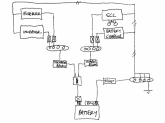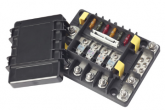TheGriz
More Power Scottie!!!
- Joined
- Feb 17, 2020
- Messages
- 128
Okay folks. I am putting all the pieces together finally. Been taking baby steps as I am a novice at best, and learning tons with each step and the continued help here of the forum members. So it's time to toss my drawing out here for review, and a sanity check. But first here are a few notes of interest before you look at my drawing:
1. I am hardly an artist. Please don't laugh too hard at my art work. I have thick skin, so I am expecting some joking!
2. Because of packaging constraints, I have put the Discharge Relay on the Negative Side of the battery, as opposed to the positive side shown in the Chargery BMS8T manual.
3. I am running the positive leg of the Solar Panels through the Charge Relay. This way, when the Overvoltage Disconnect kicks in, it also disconnects the Solar Panels, thus the Panels will disconnect when the battery disconnect. I will not have the condition of the Solar Panels connected to the MPPT SCC without a battery connected.
4. This is intended to be a portable "multi-use" Solar System. I plan on using for my RV Travel Trailer. Three 100 watt flexible solar panels will be on roof of my pickup cap with suction cups (removed of course when driving). The rest of system will be in covered bed of pickup, with the RV shore cord plugged into inverter. Secondly, I am a Ham Radio Operator and will be using for outdoor events like the annual ARRL Field Day and other ham portable comms. I am also on a Search and Rescue team as a K9 unit. When not working my German Shepherd, I will be using running comms and computers when command trailer in not on scene. And lastly, I plan to use in house during power outages, within limits of course, refrigerator, internet, TV, and couple lights.
Please see attached, and let me know if I have everything lined up correctly, or if I'm going to blow myself up...LOLOL!!!
Thank you,
Mike
1. I am hardly an artist. Please don't laugh too hard at my art work. I have thick skin, so I am expecting some joking!
2. Because of packaging constraints, I have put the Discharge Relay on the Negative Side of the battery, as opposed to the positive side shown in the Chargery BMS8T manual.
3. I am running the positive leg of the Solar Panels through the Charge Relay. This way, when the Overvoltage Disconnect kicks in, it also disconnects the Solar Panels, thus the Panels will disconnect when the battery disconnect. I will not have the condition of the Solar Panels connected to the MPPT SCC without a battery connected.
4. This is intended to be a portable "multi-use" Solar System. I plan on using for my RV Travel Trailer. Three 100 watt flexible solar panels will be on roof of my pickup cap with suction cups (removed of course when driving). The rest of system will be in covered bed of pickup, with the RV shore cord plugged into inverter. Secondly, I am a Ham Radio Operator and will be using for outdoor events like the annual ARRL Field Day and other ham portable comms. I am also on a Search and Rescue team as a K9 unit. When not working my German Shepherd, I will be using running comms and computers when command trailer in not on scene. And lastly, I plan to use in house during power outages, within limits of course, refrigerator, internet, TV, and couple lights.
Please see attached, and let me know if I have everything lined up correctly, or if I'm going to blow myself up...LOLOL!!!
Thank you,
Mike
Attachments
Last edited:






